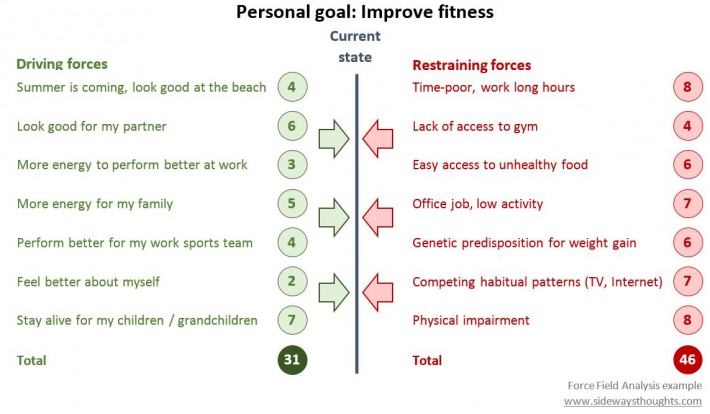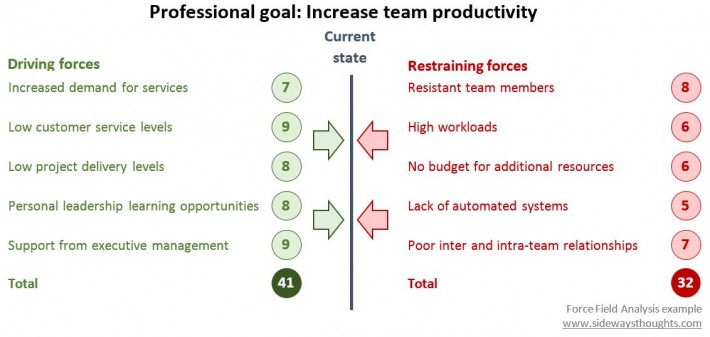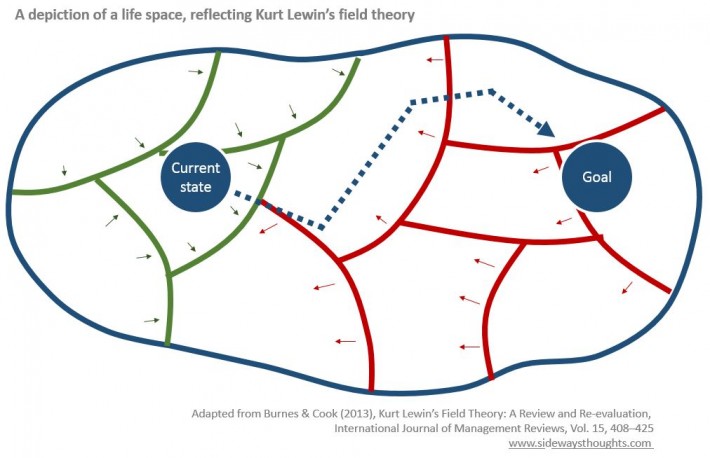A way to map a path to your goals, using Kurt Lewin’s field theory

If you want to truly understand something, try to change it. – Kurt Lewin
Taking Lewin’s quote further, you understand something more when your change efforts fail. When you view change repeatedly over time, you also understand that change is complex.
The complexity of change is exasperated by the fact that change can appear simple and easy. You are “here” and your goal is “there”. You have a personal goal to lose weight, a professional goal for career advancement, or an organisational goal to improve the productivity of your team. You are a competent and capable individual, in control of yourself and the world around you. Your objective sits as though it is just on the other side of the room, waiting for you to walk across the empty space and claim your reward.
Except the space is not empty, is it? It is full of obstacles and barriers stopping you from reaching your prize. Or at least it must be, because there is no other logical explanation for you not having your goal in hand.
In addition to barriers, perhaps there are not enough forces pushing you towards your goal. Slogans like Nike’s “Just do it” tell you it is only a matter of will. If only you wanted it more or there was a stronger burning platform to get you moving, you might leap at the opportunity.
We intuitively react to these two forces working in our lives, but often do not take the time to fully understand. It can help to map these forces out so we know and can share with others the nature of the change we are experiencing. Field theory developed by psychologist Kurt Lewin is a tool for just such a task.
Analysing your force field
Field theory presents a way to holistically look at the forces acting for and against change.
In a simple form, this is represented using a model called force field analysis. To perform a force field analysis, draw a line to represent your current state. On the left side of the line, list the forces that act for change (driving forces). On the right side of the line, list forces that act against the change (restraining forces).
You can then give each factor a score for the influence the factor has on the change. The higher the total score on one side or other determines the total force for and against change. The intent would then be to increase the score on the driving side by adding factors or increasing their scores, or alternatively reducing the score on the restraining side by removing factors or lowering the score.
Two examples below show what this might look like for a personal goal of improving physical fitness and an organisational goal of increasing productivity.


Both examples allow you to be more strategic about where you invest your resources. For the personal fitness goal, you may spend your energy feeling guilty or watching TV, or invest it in small change of a 10-minute workout in the morning. For the professional goal, you can leverage the urgency from the burning platforms of the low customer service and project delivery to make a small investment into team working relationships to bring efficiencies which will then have a flow-on effect for workloads.
A force field analysis can offer a quick assessment for the factors involve in change, but it does have limitations. These include:
- Increase driving without reducing restraining
It is easier to decrease the restraining forces rather than increase the driving forces. Increasing the driving forces without reducing the restraining forces will increase tension and make everything harder. For example, increasing the pressures to improve health or improve productivity will only increase stress if you do not address the real or perceived issue of not enough time. - Not all restraints are equal
It may not be appropriate to represent some restraining forces as being pushed back or to score them equally. Scoring two restraining issues the same may be irrelevant if one of them is a safety risk that may kill you. - Showing indirect impacts
There are factors that do not directly impact the change but have an indirect impact. Your partner’s schedule may not directly impact your workout routine, but perhaps there are ways that changing their schedule can free up your time an allow you to realise your goals.
Map your path
Lewin understood that change requires an understanding of all the factors that impact the change. This is particularly the case when things have become routine, established, and resistant to change. As one recent article states: “In order to understand, predict and begin to change behaviour, it is necessary to take into account everything about the person and his/her perceptual or psychological environment in order to construct the person’s life space.”
These forces are psychological. Coming out of a meeting with oppositional team members may feel like you have been hit by a train, but there are no train tracks to be found. Reading an email of support from the CEO may feel like you have the wind in your sails, but you remain seated on dry land. These invisible forces pushing and pulling your thoughts and behaviour combine to create what Lewin referred to as your life space.
This life space can be represented as a topology or map we navigate towards our goals. This topology is constantly shifting. Mountains rise and fall. Chasms open and bridges are created. The goal may at times seem like it remains on the horizon, or barriers may fall and it is suddenly within reach.
The diagram below shows a way of representing this life space map. Your current state is shown on one end and your goal on the other. Around you and your goal are forces that contribute to and restrain you realising your goal.

As shown, change is rarely a linear path from here to there. We may focus on one or two driving forces, such as a key relationship. As soon as we start, we may come head-on with a key challenge and need to take a sideways turn. We gain some skills, learn to adapt and overcome, and turn back towards our goal and overcome the challenge.
Viewing our journey as the map highlights a few principles:
- It is subjective
The map is created from the perspective of whoever is defining the current state. This is important when working with teams, as where we are, where we going, and the drivers and barriers to getting there will be different from each perspective. - It is the whole system
The approach incorporates the full environment into the change decisions. There may be some factors that do not directly impact the change, but there is space to capture these on the outside as indirect contributing factors. - Each factor is independent and interdependent
Increasing or decreasing the size and pressure of one factor will have an impact on the overall map, but each factor can also be focused on and have specific strategies independent of other factors. - Tension and conflict
There is inherent tension as a result of competing pressures. We tend to structure our personal and professional environments to minimise tension and have equilibrium. But as soon as we want to move from our current state towards a goal, we create tension and conflict. The question is not whether there will be conflict, but how we will navigate this conflict towards our goal and how we grow along the way.
Applying the model
If you are in a process of moving from “here” to “there”, you may want to consider having a try at creating a map of your path. It can also help to have the conversation with someone else from a coaching or facilitating perspective.
- Write down your goal. Be specific, such as work out three times per week, lose 10 pounds, increase productivity by 5%, etc.
- List all the factors you feel are influencing you ability to achieve that goal. Label these as drivers and restraints and give them a number from 1 to 10 based on the degree of impact they have on you realising your goal.
- Draw a circle for your current state on the left side of a blank paper, and a circle for your goal on the right side.
- Draw shapes to represent the restraining factors in the space between your current state and your goal, the greater the impact the larger the shape. Draw shapes for the driving forces to the left of your current state. Again, the greater the impact, the larger the shape.
- Now consider your path from your current state to your goal. Which drivers will best support you and that you can reinforce or leverage? What barriers are the easiest to reduce and can provide you with a clearer path to your goal?
There is no single model that will work in all situations, but drawing out a map may be helpful for those who are more visual. Mapping your drivers and challenges can allow you to explore new paths to your goal and create strategies to get there.
These blog posts are part of my own journey to my goal as I leverage strengths and overcome challenges. Thank you for joining me, and please pass this on if you feel it would help someone else define and navigate their own life space.
Image credit: www.GlynLowe.com, Views From The Sea Discoveries Monument – Wind Rose World Map https://flic.kr/p/cu6K6y
